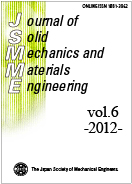Volume 6, Issue 5
Displaying 1-7 of 7 articles from this issue
- |<
- <
- 1
- >
- >|
Review Paper
-
2012Volume 6Issue 5 Pages 323-338
Published: 2012
Released on J-STAGE: May 31, 2012
Download PDF (1191K)
Papers
-
2012Volume 6Issue 5 Pages 339-350
Published: 2012
Released on J-STAGE: May 31, 2012
Download PDF (622K) -
2012Volume 6Issue 5 Pages 351-360
Published: 2012
Released on J-STAGE: May 31, 2012
Download PDF (294K) -
2012Volume 6Issue 5 Pages 361-373
Published: 2012
Released on J-STAGE: May 31, 2012
Download PDF (5117K) -
2012Volume 6Issue 5 Pages 374-382
Published: 2012
Released on J-STAGE: May 31, 2012
Download PDF (1995K) -
2012Volume 6Issue 5 Pages 383-396
Published: 2012
Released on J-STAGE: May 31, 2012
Download PDF (1530K) -
2012Volume 6Issue 5 Pages 397-406
Published: 2012
Released on J-STAGE: May 31, 2012
Download PDF (521K)
- |<
- <
- 1
- >
- >|
